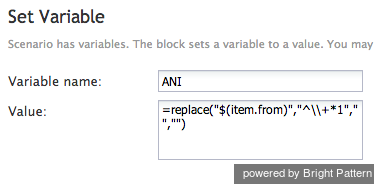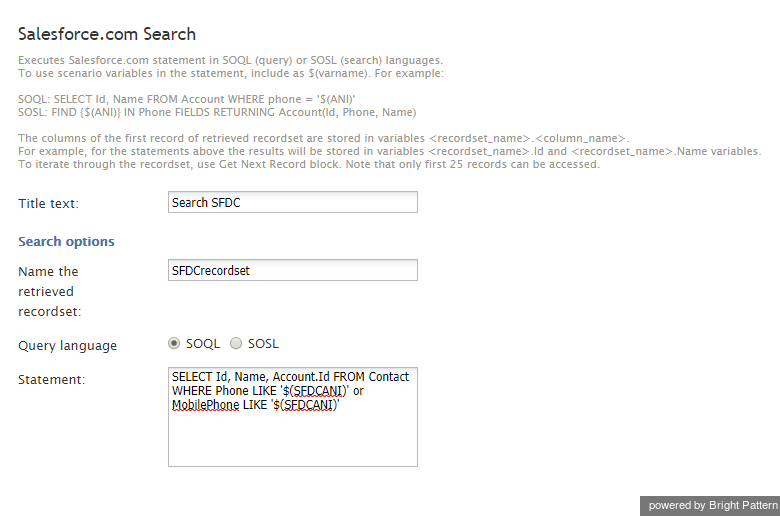From Bright Pattern Documentation
m |
(Updated via BpDeleteTranslateTags script) |
||
| Line 1: | Line 1: | ||
| − | + | = Searching for a Contact Using the Salesforce.com Search Block= | |
This section describes the various ways to use scenario blocks when searching for a contact. For more information on scenario blocks, see the ''Scenario Builder Reference Guide''. | This section describes the various ways to use scenario blocks when searching for a contact. For more information on scenario blocks, see the ''Scenario Builder Reference Guide''. | ||
| − | == How to Clean the ANI Using Set Variable == | + | == How to Clean the ANI Using Set Variable == |
Use the [[scenario-builder-reference-guide/SetVariable|Set Variable]] block with the following properties to clean the ANI from any meaningless symbols. | Use the [[scenario-builder-reference-guide/SetVariable|Set Variable]] block with the following properties to clean the ANI from any meaningless symbols. | ||
| − | |||
* '''Variable Name:''' ANI | * '''Variable Name:''' ANI | ||
* '''Value:''' | * '''Value:''' | ||
| Line 11: | Line 10: | ||
| − | |||
[[File:sfdc-integration-guide-image34.png|thumb|800px|center|]] | [[File:sfdc-integration-guide-image34.png|thumb|800px|center|]] | ||
| − | == How to Set a Value for the SFDCANI Using Set Variable == | + | == How to Set a Value for the SFDCANI Using Set Variable == |
Use the [[scenario-builder-reference-guide/SetVariable|Set Variable]] block with the following properties to set a value for the SFDCANI. | Use the [[scenario-builder-reference-guide/SetVariable|Set Variable]] block with the following properties to set a value for the SFDCANI. | ||
| − | |||
* '''Variable Name:''' SFDCANI | * '''Variable Name:''' SFDCANI | ||
* '''Value:''' | * '''Value:''' | ||
| Line 24: | Line 21: | ||
| − | |||
[[File:sfdc-integration-guide-image35.png|thumb|800px|center|]] | [[File:sfdc-integration-guide-image35.png|thumb|800px|center|]] | ||
| − | == How to Use the Salesforce.com Search Block == | + | == How to Use the Salesforce.com Search Block == |
Use the [[scenario-builder-reference-guide/Salesforce.comSearch|Salesforce.com Search]] block with the following SOQL query: | Use the [[scenario-builder-reference-guide/Salesforce.comSearch|Salesforce.com Search]] block with the following SOQL query: | ||
| − | + | ||
SELECT Id, Name, Account.Id FROM Contact WHERE Phone LIKE '$(SFDCANI)' or MobilePhone LIKE '$(SFDCANI)' | SELECT Id, Name, Account.Id FROM Contact WHERE Phone LIKE '$(SFDCANI)' or MobilePhone LIKE '$(SFDCANI)' | ||
| − | |||
[[File:SFDC-Search-Block-50.PNG|650px|thumbnail|center|Salesforce.com Search properties]] | [[File:SFDC-Search-Block-50.PNG|650px|thumbnail|center|Salesforce.com Search properties]] | ||
| − | |||
| − | |||
| − | |||
| − | |||
| − | |||
Latest revision as of 04:03, 29 May 2024
• 日本語
Searching for a Contact Using the Salesforce.com Search Block
This section describes the various ways to use scenario blocks when searching for a contact. For more information on scenario blocks, see the Scenario Builder Reference Guide.
How to Clean the ANI Using Set Variable
Use the Set Variable block with the following properties to clean the ANI from any meaningless symbols.
- Variable Name: ANI
- Value:
=replace("$(item.from)","^\\+*1","","")'
How to Set a Value for the SFDCANI Using Set Variable
Use the Set Variable block with the following properties to set a value for the SFDCANI.
- Variable Name: SFDCANI
- Value:
=replace("$(ANI)","(\\d{3})(\\d{3})(\\d{4})","%\\1%\\2%\\3%","")
How to Use the Salesforce.com Search Block
Use the Salesforce.com Search block with the following SOQL query:
SELECT Id, Name, Account.Id FROM Contact WHERE Phone LIKE '$(SFDCANI)' or MobilePhone LIKE '$(SFDCANI)'



